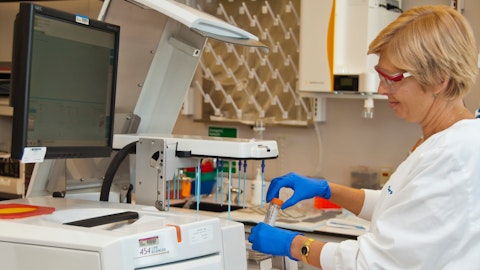Mark Keim: So a couple of things, and good morning, Josh. Our metallic mix has remained unchanged. So what you’re seeing in Marketplace is not at all metallic or mix related. That’s state footprint related. As you know, we’re in 14 states, and our mix among the states, as we’re more competitive in some, maybe not so much in others, our mix does shift a little bit. So that’d be the driver there. On Bright, on the PDR, with the PDR that was booked before we bought the business, that benefits the MLR and pulls it down to a level that’s actually a little bit below our target range. Now remember, our target range is largely DSNP and MMP because that’s our legacy Medicare book. On the bright with the PDR in the MLR line, it does pull it down a little bit below our target range.
Josh Raskin: So how does that impact — I’m just trying to — so it feels like with the PDR, you guys will sort of reverse that through the year. How does the embedded earnings go up? Right. I’m confused with how is Bright, MLR low, but they’re losing more money?
Mark Keim: It’s a good question and thanks for raising that. I knew we were going to get that sooner or later. So with the PDR, as you know, the PDR should largely normalize expected operating losses on a contract year. PDR accounting doesn’t allow you to put all of the losses into the PDR. There are certain accounting matters that are still held out. So even with the PDR, I’ll have a very small operating loss, Josh. But the other thing is when we talk about embedded earnings, we always include the carrying costs. The embedded earnings are essentially fully capitalized or fully funded for their carrying costs. So when I say I have about $0.50 of dilution this year, it’s about half operating costs that aren’t covered by the PDR and about half carrying costs.
Remember we paid about a half billion. The opportunity cost or interest on that is maybe the other half of the $0.50. So as a result, I’m carrying a $0.50 hole in this year’s EPS bridge. Since that’s a $0.50 hole, I said I’d have $1 of ultimate benefit from this property. The dollar now goes to $1.50 because I’m going to crawl out of that hole over the next couple of years.
Josh Raskin: Okay. Got it. Thanks.
Operator: The next question comes from Justin Lake with Wolfe Research. Please go ahead.
Justin Lake: Thanks. Good morning. I just want to follow up on Bright. So a few things here. First, can you give me the PDR number that you put through there for 2024?
Mark Keim: Sure, we acquired the business with a $75 million PDR on the balance sheet.
Justin Lake: Okay, and so you’re saying the — I understand the PDR getting it to normal levels potentially, but how does the PDR get it below normal MLR levels?
Mark Keim: The PDR books all of the losses. It picks up a little bit of the G&A losses, with the medical cost losses, and books them into the medical cost line. So to the extent that there were some G&A items, it’ll get picked up in the MLR line. It’s just an accounting convention where the net of losses get picked up in one line item or the other.
Justin Lake: Okay, so your point is that just thinking about the math of this, the MLR is going to go up next year because it’s actually below normal and you’re saying the SG&A will come down.
Mark Keim: There will be a little bit of that, Justin.
Justin Lake: Okay. And you expect to get this full dollar back plus in 2025?
Joe Zubretsky: And that’s the important point. The important point here, first of all, the first year losses were fully contemplated in the value we paid. So there was no surprise there. The business is running at a 92% MCR and a 14% G&A ratio. We plan to get the 92% down to 88% to 89% and the 14% down to 9% to 10%. So half to two thirds of the turn is G&A related and we have very, very clear line of sight to how to take their cost burden down from 14% to 9% or 10% where it should be. That dollar of accretion is expected to emerge in the third full year of ownership. First year protected by — mostly protected by a PDR. Second year, breakeven to probably slightly profitable. Full dollar of accretion in the third full year of ownership. Getting the MCR from 92% down to 88% or 89%, getting the 14% G&A ratio down to 9% or 10%.
Justin Lake: Got it. And then lastly, just on, there’s a big RP as you know in Florida, I think a lot of anticipation there around when that might be communicated. My understanding is we’re kind of into the second round in negotiations. I assume you can’t tell us whether you’re still kind of in the running there, but any idea given that given where you are today, any idea when you think that under normal conditions that MLR would be announced? Or should the RFP would be announced, not the MLR?
Joe Zubretsky: Sure, sure. And we appreciate your sensitivity to the situation. Yeah, we observe the sanctity of all these bidding processes, including the ITN process, so we can’t comment specifically on it. But look, as we — yet we run a nice business in Florida. It’s smaller than it used to be to regions. We used to be statewide back in 2017. It runs really well. We’re the only four-star plant in Florida. And the same team that works on all our successful bids, our $12 billion of re-procured revenue and our $7 billion of new contract wins, that is the same team that worked on this. So we go into it with a great deal of confidence and we would hope to expand our footprint in Florida. There’s $14 billion of Medicaid revenue in Florida regions where we are not currently represented. But let’s see how the process plays out and hopefully something will be announced, awards will be announced sometime later this spring.
Justin Lake: Thanks for the color.
Operator: The next question comes from Stephen Baxter with Wells Fargo. Please go ahead.
Stephen Baxter: Hi, thanks. I appreciate all the commentary on your Medicaid expectations for the year. I was hoping you could help us think about the bridge from your Medicaid MLR exit in the year to your same-store Medicaid MLR in 2024, around the midpoint of the range. I’m curious if you think that the [core] (ph) could kind of get there earlier in the year because some of the one-one rate adjustments that we’ve been focused on, or do you think that’ll take some time to work through the business and then other seasonal factors play out? Thanks.
Joe Zubretsky: As a general framework for how we stay within our long-term range year-over-year, in fact, on the same story basis, almost equivalent, we talk about the redetermination process, which late in 2023 began to put pressure on the MLR until rates caught up with it. As Mark commented in his prepared remarks, we know about Medicaid rates on 80% of our revenue for 2024. That rate increase came in at 4%. So that blends to about 3.2%. We forecasted the other 20% at less than half that. So we have a 3.5% rate increase built into our 2024 guidance. And that was exactly commensurate with trend, trend even as influenced by the modest acuity shift that we and our state customers have observed. So pretty much business as usual.
There’s nothing, no medical cost category that needed to be accounted for or accommodated. It’s actuarially sound rates impacted by acuity adjustments that 20 of 21 of our states included. And it was completely in line with our contemplated medical cost trend, even as influenced by an acuity shift. Mark, anything to add?
Mark Keim: No, I think that’s exactly right. As we look at the rates and the trend being roughly equal, our legacy book pretty much holds flat. As you know, we’re bringing in a bunch of additional new business that puts a little more pressure in the first year, which rounds us out at the 89% that we have in guidance.
Operator: The next question comes from Nathan Rich with Goldman Sachs. Please go ahead.
Nathan Rich: Hi, good morning and thanks for the questions. I wanted to ask on the Marketplace MCR, I guess moving back to the low end of the long-term range. So up about 300 basis points year-over-year. Can you just talk about what’s driving that increase year-over-year? Is that just a function of the membership growth that you saw? And then have you thought of — how, I guess, are you thinking about maybe the long-term target for that business? Is 78% to 80% still the right range to use? And then just one clarifying question for Mark. I think you said quarterly EPS is weighted towards the back half of the year. I think usually the back half is about 45% of the total year. So does that mean this year will be over 50% or is that not the right way to interpret the comment that you made? Thank you.




